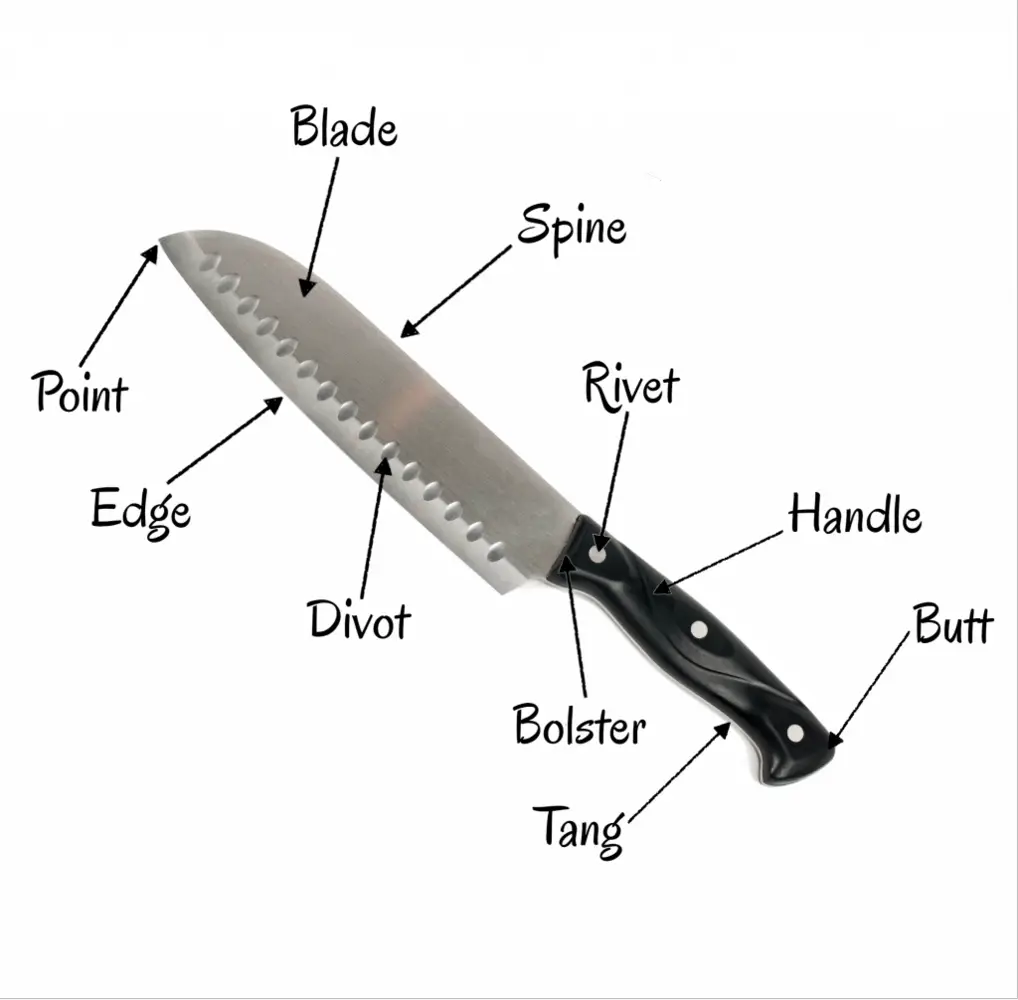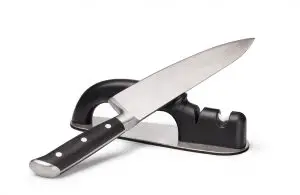A beautifully sharp knife makes all the difference in the kitchen. Although we all love how versatile our chef’s knife can be, using the right knife for the right task will significantly CUT down time from prep to serving. This complete guide to kitchen knives will help you be sharper in the kitchen.
Basic Anatomy Of The Knife

Point
The very tip of the knife. Mainly used for puncturing.
Blade
The steel portion of the knife.
Edge
The leading edge of the blade used for cutting, slicing, chopping etc.
Spine
The back, blunt end of the blade.
Divot/Indent
The indents running along the blade. Helps slice smoothly as the indents create spaces between the blade and the food you are slicing.
Bolster
The joining between the blade and the handle which influences balance and weight. Can range from full bolster, half bolster, or no bolster. A full bolster provides extra protection as there is no sharp edge near the handle.
Rivet
The steel pins holding the handle and blade together.
Handle
Where you hold the knife, consisting of the rivets, tang, butt, and scale.
Butt
The end of the handle.
Tang
Tang refers to the steel portion of the knife that extends into the handle. A full tang is where the steel runs from tip to butt. The tang can also be partial.
Choosing The Right Knife
Chef Knife
The chef’s knife is definitely the most important knife to have in the kitchen, whether you’re a professional or an amateur. Overall, It’s the best knife for cutting raw meat, cooked meats, or vegetables. It’s one of the only knives that can be used in both preparation, and when serving – provided you are washing it in between!
A chef’s knife is an all-in-one knife that will be able to do it all effectively for the everyday chef. Because it’s used more frequently than any other knife, it’s best to go for quality so you’ll get the most out of it.
Santoku Knife
Similar to the chef’s knife, the Santoku knife can be used as a valuable all-rounder. The blade is wider and has indents along the surface that helps prevent foods from sticking to the knife as it cuts and slices. It’s excellent for prep work and its design helps if you require thinner slices.
Overall, the Santoku knife is the best Japanese knife for cutting vegetables.
Bread Knife
Usually, a bread knife will be between 8-10 inches long and behaves like a saw, with the serrated edge catching on the food and cutting through surfaces by making continuous tears. The perfect knife for slicing through the crust of bread without crushing it, hence the name. It also works particularly well when cutting soft fruits and vegetables.
Meat Cleaver
Traditionally, butchers would use the cleaver to hack and slash through meat and bone. Although this is a specialized knife, there are actually many essential tasks that the cleaver makes a breeze due to its size, weight, and blade. Because of this, the humble meat cleaver has made its way into the kitchens of amateur chefs and culinary enthusiasts all over the world.
Check out the best meat cleavers in the market in 2020.
Boning Knife
A boning knife is a specialized and extremely handy knife to have around the kitchen. It’s sharp and very flexible which makes it exceptional at deboning, trimming, and preparing meats before cooking. Boning knives are lightweight, come between 4 to 6 inches in length, and usually are made with high quality, but flexible steel.
The flexibility and sharpness make it effortless to prepare your meats and is the best knife for trimming brisket or trimming the fat off any other meats.
Utility Knife
The utility knife is shorter, and sturdier than a chef’s knife, but plays a similar part in the kitchen. That is, it’s great to do almost any task, particularly when you’ll benefit from using a shorter knife than a chef’s, or Santoku knife.
Great for preparing fruits, trimming fat, slicing, dicing, chopping, and piercing foods. Utility knives are reasonably priced, and often come in knife sets – so make sure you utilize it if you have one.
Paring Knife
The paring knife is designed for precision. It’s a much smaller 2 to 4-inch knife with a thin blade. It’s lightweight, sharp, and allows for absolute control. Best used when coring apples, preparing fruits, trimming small vegetables, etc.
Definitely one of the most iconic and best knives for cutting fruit.
Carving Knife
The carving knife, or slicing knife, has a long thin blade with a sharp tip. It’s specialized for slicing and carving larger pieces of meat into thinner pieces in order to serve up the feast. Although they generally range from 8 to 16 inches, if you want one that’s good for everything but still excellent at larger meats, then a safe pick to go for is a 12 to 16-inch carving knife.
Butchers Knife
A butcher’s knife is designed to break down large pieces of meat into smaller pieces. For example use on breaking down a whole pork tenderloin or full chicken. This is because it’s got a much thicker and sturdier blade, ideal for chopping and slicing all kinds of meat, even cutting frozen meat.
Fillet Knife
The fillet knife is similar to both the boning knife and the utility knife, in that another specialist knife for control and precision. It’s a long, thin, and sharp blade, which makes it the best knife for filleting fish.
Steak Knife
Steak knife is designed for well… steak. It’s a slightly serrated edge helps cut the steak like butter. As you slice back and forth the serrated edge easily tears through the seared outside edge. Definitely a must have for when you’re having steak, chicken, or any meat really.
Tomato Knife
I think we’ve all had a bad experience when trying to slice tomatoes up. A tomato knife is brilliantly designed to slice tomatoes without having any of the juice gushing out. It’s like a steak knife in size, has a serrated edge, but has a dual pointed tip.
Does The Steel Matter?
The main types of steel that you will come across in the market are either German or Japanese. Although there are others, German or Japanese engineered steel knives are much more common. The key differences between them are hardness, tang, sharpness, and durability.
Hardness is measured on the Rockwell Hardness Scale (HRC, or Hardness Rockwell C). Depending on the knife, you’ll find it measures between 50-65 Rockwell. Tougher steel stays sharper for longer, but softer steel is easier to sharpen.
Tang refers to how far the steel blade runs into the handle. A knife with full tang will have the steel run from tip to the butt of the knife. Whereas partial tang will have the steel running only part way into the handle.
Sharpness is determined by how thin the edge of the knife is, and at what degree it’s sharpened at. The rule of thumb is you always want a sharp knife, as it makes everything easier and you’re actually more likely to injure yourself when using a blunt knife.
German Steel
German steel almost always has a bolster and a full tang. They are purposely heavier than other steels and are engineered for durability. German steel knives are usually engineered between 55-58 Rockwell hardness and sharpened around the 20-degree mark.
Japanese Steel
Japanese steel knives are at the pinnacle of sharpness and often much more lightweight than German steels. They are sharpened at around a 15-degree mark, and are made with tougher steel, measuring usually around 58 or more Rockwell. Japanese knives such as the Yanagiba knife, or the Deba knife, don’t often have a full bolster and aren’t as hefty as German knives.
Taking Care Of Your Knives
Keeping It Sharp
Using a sharp knife won’t just make it easier to do your essential cooking tasks, it will CUT the time down too. Pardon the pun, but it really does make the biggest difference. The most common mistake people make after purchasing quality knives is believing they will stay sharp forever. This is simply not the case, and no knives are designed to stay sharp forever.
You can get precise angles by using a whetstone, but even an everyday knife sharpener will do the same job. Sharpen your knives as frequently as you need depending on how often you’ve been using them.

When you’re using an everyday knife sharpener, be sure to keep the knife as straight and even as possible. Firmly swipe the knife through the coarse sharpener a few times from the bottom to the point, then repeat the process on the fine side.
Honing Steel
Almost as important as keeping the knife sharp, you should also hone the edge of your knife by using a honing steel. Another misconception is that this tool also sharpens your knife when in reality it just helps keep it straight and the edge consistent. Honing your knife will help it maintain its sharp edge for longer.
The best honing steel should be longer than the knife you are honing, be made of tough material, and shouldn’t be too abrasive so it doesn’t scratch or damage the knife.
Cutting Boards
Always use a wooden cutting board when using your knives. The wood provides enough resistance without blunting the knives. Synthetic plastic cutting boards are fine to use too, just avoid surfaces such as metal, stone, or glass and these will quickly blunt or damage the blade.
Storage And Sheaths
To maintain the quality of your knives, always store them correctly. Some knives come with unique sheaths that are designed to hold the knives without exposing the steel, which helps it stay durable and sharp.
If you don’t have a protective sheath for the knife try storing it in conditions where it can’t move around so it won’t dull or be damaged. You can store them in a knife block or suspend them on a rack or knife bar for example.


